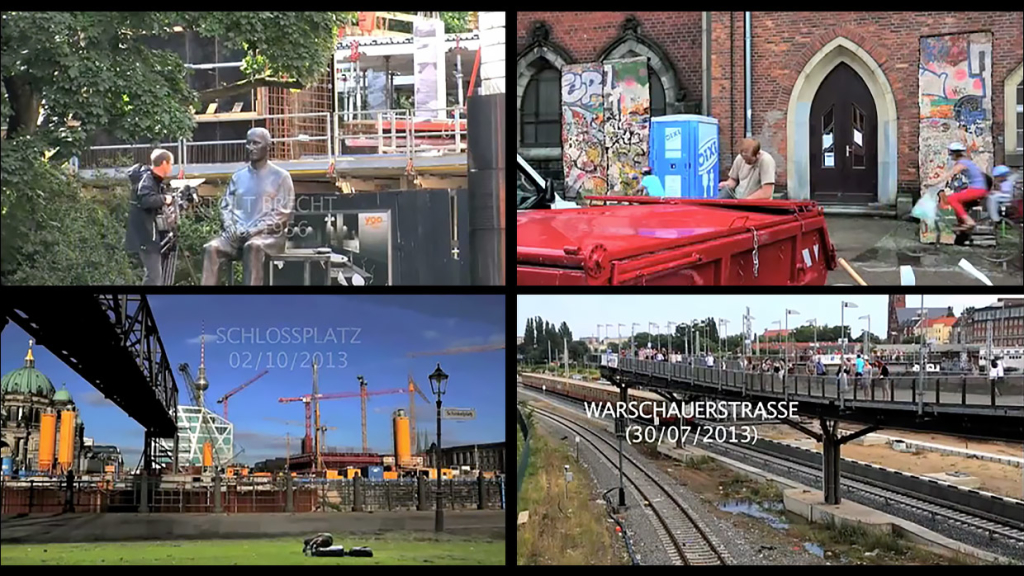Pierre Hébert: BERLIN – THE PASSAGE OF TIME

Video Installation
Vier Videoclips verschiedener Länge zum Thema Berlin laufen als Loops auf vier Flachbildschirmen. Die ständige Verschiebung der Clips zueinander, hervorgerufen durch die verschiedene Länge, sowie die digitale und animationstechnische Bearbeitung der Alltagsszenen mit Bezug auf die jüngere Vergangenheit Berlins, aber auch auf Personen wie Bert Brecht oder Walter Benjamin, erzeugen eine Art historisches Vertigo. Der Betrachter/Zuhörer wird eingeladen, sich innerhalb der komplexen Bild- und Tonebenen wechselseitig zu positionieren und in der konzentrierten Beobachtung der Fragmente beim Wechsel zwischen den einzelnen Monitoren
Video Installation
The Berlin – The Passage of Time video installation is shown on four HD flat screens. Four video clips of different lengths (between seven and twelve minutes) are looped on those screens. Since the loops are of different lengths, they are constantly lagging one in relation to the others so that the viewer is facing ever changing combinations of the different segments of images and sounds.
Each of the segments is based on shooting done in Berlin in July 2012, august 2013 and October 2013. All those shootings have to do with scenes of daily life, but in the same time, they also refer to different episodes of the recent history of the city of Berlin, from the Weimar Republic to the Second World War, the monumental buildings of the DDR, the 1949 blockade and airlift, the Wall and so on to the current rebuilding of the city center. Some segments (images shot from the S-Bahn, the parade of the tourists boats on the Spree, the constant traffic of bicycles) have a function of transitions and constitute leitmotivs that are present in all four screens.
There are two segments devoted to two major intellectual figures related to Berlin, that are dear to me, Bertolt Brecht and Walter Benjamin, two characters that had crossed over destinies during WW II. Overall the piece is particularly inspired by different benjaminian themes, like the image of the «flanneur», a special understanding of history and of the relationship between present and pass, the notions of dialectic images and allegory.
Each shot is first submitted to digital processing in order to achieve a greater density of the material. Eventually, meshes of animated lines are added. The objective is, while keeping a strong connection with the initial raw live material, to modify the viewer’s perception, to allegorize those fragments of daily life, and to create a sort of historical vertigo. At another more formal level, there is a construction of moments of intensity that creates at the level of the four screens a composition of dynamic chocks constantly reenacted by the lag between the four different loops. This is superposed to the equally shifting thematic connections between what is seen on the different screens. This combinatory and expanded editing on multiple levels invites the viewer to position himself alternately in the overall contemplation of the changes in the global installation, and in the concentrated observation of specific fragments while moving from one screen to the other.
The longest loop is 13 minutes, so the complete set of images of the piece can be seen in that length of time. But, because of the combinatory manner in which it is constructed, it is possible to stay in hypnotic contemplation much longer in front of the installation.
This installation piece is subtitled “Places and Monuments-6” because it is number 6 of a wider project that will eventually include a large number of glimpses of the course of things from all over the world. Up to now in this series of works, four short films were completed : Praha-Florenc (no 1), Place Carnot – Lyon (no 2), Thunder River (no 4), and John Cage – Halberstadt (no 5). A Tokyo piece (no 3) is unfinished. A web version of Berlin – The Passage of Time was put on line at the time of the first presentation of the installation.
http://pierrehebert.com/berlin-the-passage-of-time/
pierrehebert.com
Illustration overleaf: Filmmachine 5.1/Spy film, 1991-2014,
unperforated 16mm film, marker, steel, electric drive,
78 x 74 x 30 cm

